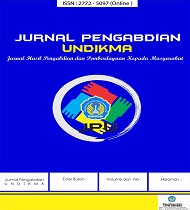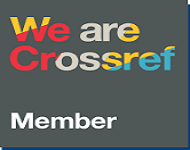SIKU Interactive Media: The Development of Learning Media to Improve Student Financial Literacy
DOI:
https://doi.org/10.33394/jk.v8i2.4770Keywords:
SIKU Interactive, Learning Media, Financial Literacy Economics.Abstract
References
Budiyono. (2016). Statistika Untuk Penelitian. Surakarta: UNS Press.
Chen, H. Volpe R.P. (1998). An Analysis of Personal Financial Literacy of Among College Students. Financial Services Review, 7(2).
Daryanto, Suryatri Darmiatun. (2013). Implementasi Pendidikan Karakter di Sekolah. Yogyakarta: Dava Media.
Dikra, O., & W.S.U. (2016). Pengaruh Literasi Keuangan dan Pengendalian Diri Terhadap Perilaku Konsumtif Mahasiswa Jurusan Ekonomi Pembangunan Fakultas Ekonomi Universitas Negeri Malang Angkatan 2013. Jurnal Pendidikan Ekonomi, 9(2), 143-155.
Halim, Y.K.E., & Astuti, D. (2015). Financial Stressors, Financial Behaviour, Risk Tolerance, Financial Solvency, Financial Knowledge, dan Kepuasan Finansial. Finesta, 3(1), 19-23.
Hastings, J.S., Madrian, B.C., & Skimmyhorn, W.L. (2013). Financial Literacy, Financial Education, and Economics Outcomes. Annual Review of Economics, 5, 347-373.
Ilyana, S., & Sari, R.C. (2015). Pengembangan Komik Edukasi Sebagai Media Pembelajaran Literasi Keuangan untuk Siswa Sekolah Dasar. Jurnal Pendidikan Akuntansi Indonesia, 13(2).
Jariwala, Harsha. V. (2013). To study the level of financial literacy and its impact on investment decision-an in-depth analysis of investors in Gujarat State. Management, Ganpat University, Gujarat India.
Luhsasi, D.I. (2017). Penggunaan Game Online Berkategori Casual Sebagai Sarana Pendidikan Literasi Keuangan dan Pengelolaan Keuangan Mahasiswa. Jurnal Riset Akuntansi & Keuangan, 5(2), 1501-1514.
Lusardi, A., & O.S. Mitchell. (2014). The Economics Importance of Financial Literacy: Theory and Evidence. Journal of Economics Literature, 52(1).
Margaretha, F., Krishna, A., Rofaida, R., & Sari, M. (2010). Analisis Tingkat Literasi Keuangan di Kalangan Mahasiswa dan Faktor-Faktor yang Mempengaruhinya. Proceedings of the 4th International Conference on Teacher Education.
Margaretha, F., & Pambudhi, R.A. (2015). Tingkat Literasi Keuangan Pada Mahasiswa S-1 Fakultas Ekonomi. Jurnal Manajemen dan Keuangan, 17(1).
Munadi, S. (2011). Pengembangan Modul Pembelajaran Konstruktivistik Kontekstual Berbantuan Komputer Dalam Matadiklat Pemesinan. Jurnal Pendidikan Vokasi, 1(1), 51-67.
Munadi, Yudhi. (2013). Media Pembelajaran. Jakarta: GP Press Group.
Nurseto, T. (2011). Membuat Media Pembelajaran yang Menarik. Jurnal Ekonomi & Pendidikan, 8(1).
Ross, Keith., Lakin, Liz., Callaghan, Peter. (2004). Teaching Secondary Science. London. David Fulton.
Sari, D.A. (2018). Sosialisasi dan Edukasi Literasi Keuangan untuk Warga ‘Aisyiyah Kabupaten Sukoharjo Guna Mengurangi Perilaku Konsumtif Pada Remaja dan Anak-Anak. Jurnal Inovasi Hasil Pengabdian Masyarakat, 2(2), 88-99.
Sari, D.A. (2019). Pendidikan Literasi Keuangan Melalui Program Kemitraan Dengan Bank untuk Mengurangi Perilaku Konsumtif Pada Mahasiswa. Jurnal Pendidikan dan Ilmu Sosial, 28(1), 22-30.
Setiyowati, A., & Lailatullailia, D. (2020). Literasi Keuangan Syariah Melalui Media Edukatif untuk Anak Usia Sekolah Dasar di SD Muhammadiyah Surabaya. Humanism Jurnal Pengabdian Masyarakat, 1(1).
Sina, P.G., & Noya. A. (2012). Pengaruh Kecerdasan Spiritual Terhadap Pengelolaan Keuangan Pribadi. Jurnal Manajemen, 11(2).
Sitorus, D.S. (2019). The Effectiveness of Accounting E-module Integrated with Character Value to Improve Students’ Learning Outcomes and Honesty. Jurnal Cakrawala Pendidikan, 38(1), 120-129.
Sitorus, D.S. (2021). Analisis Tingkat Literasi Keuangan Siswa SMA Kristen Satya Wacana. ECOBISMA (Jurnal Ekonomi, Bisnis, dan Manajemen), 8(2), 27-34.
Sudjana, Nana & Rivai. (2009). Media Pengajaran. Bandung: Sinar Baru Algesindo.
Suhartini, D., & Renanta, J.A. (2007). Pengelolaan Keuangan Keluarga Pedagang Etnis Cina. Jurnal Riset Ekonomi dan Bisnis, 7(2), 70-81.
Suryani, N. (2016). Pengembangan Media Pembelajaran Sejarah Berbasis IT. Jurnal Sejarah dan Budaya, 10(2).
Triani, A., Mulyadi, H. (2019). Peningkatan Pengalaman Keuangan Remaja Untuk Literasi Keuangan Syariah yang Lebih Baik. I-Finance: A Research Journal on Islamic Finance, 5(1), 9-22.
Downloads
Published
How to Cite
Issue
Section
Citation Check
License
License and Publishing Agreement
In submitting the manuscript to the journal, the authors certify that:
- They are authorized by their co-authors to enter into these arrangements.
- The work described has not been formally published before, except in the form of an abstract or as part of a published lecture, review, thesis, or overlay journal.
- That it is not under consideration for publication elsewhere,
- That its publication has been approved by all the author(s) and by the responsible authorities tacitly or explicitly of the institutes where the work has been carried out.
- They secure the right to reproduce any material that has already been published or copyrighted elsewhere.
- They agree to the following license and publishing agreement.
Copyright
Authors who publish with JK agree to the following terms:
- Authors retain copyright and grant the journal right of first publication with the work simultaneously licensed under a Creative Commons Attribution License (CC BY-SA 4.0) that allows others to share the work with an acknowledgment of the work's authorship and initial publication in this journal.
- Authors are able to enter into separate, additional contractual arrangements for the non-exclusive distribution of the journal's published version of the work (e.g., post it to an institutional repository or publish it in a book), with an acknowledgment of its initial publication in this journal.
- Authors are permitted and encouraged to post their work online (e.g., in institutional repositories or on their website) prior to and during the submission process, as it can lead to productive exchanges, as well as earlier and greater citation of published work.
Licensing for Data Publication
-
Open Data Commons Attribution License, http://www.opendatacommons.org/licenses/by/1.0/ (default)

This work is licensed under a Creative Commons Attribution-ShareAlike 4.0 International License.







